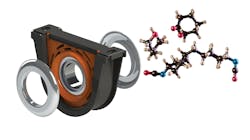Why buy polyurethane truck parts?
Because there is no “one-size-fits-all” approach to choosing the right materials to use in the manufacturing of vehicle parts, truck manufacturers will opt for materials that serve the best function while also considering supply and labor costs. Therefore, they are more likely to consider using rubber for many suspension parts over other materials; and it is no wonder why. Rubber has great physical properties used to reduce vibrations and it is cost-effective for both buyers and sellers.
However, when it comes to environmental factors and product longevity in certain applications, sometimes rubber is not the most suitable. Instead, some component makers, such as Meritor’s GAFF brand, utilize polyurethane as their material of choice for truck suspension parts over the highest quality rubber.
The science behind polyurethane
Polyurethane is a versatile plastic material used in a variety of applications, with durability advantages over rubber, including higher resistance to abrasions, cuts, and tears.
According to the American Chemistry Council (ACC), “Polyurethanes are formed by reacting a polyol (an alcohol with more than two reactive hydroxyl groups per molecule) with a diisocyanate or a polymeric isocyanate in the presence of suitable catalysts and additives. Because a variety of diisocyanates and a wide range of polyols can be used to produce polyurethane, a broad spectrum of materials can be produced to meet the needs for specific applications.”
With unique chemical properties, this heavy-duty material can be molded into unusual shapes. This adaptability has helped to solve problems found in numerous industries including mining, paper processing, concrete, energy, building, apparel, and transportation.
In the commercial trucking industry, polyurethane is used for sealants, coatings, and adhesives, and is often used on vehicle interiors and exteriors for seats, bumpers, doors, and windows. According to the ACC, thermoplastic polyurethanes, one of many types of polyurethane materials, are praised by trucking manufacturers for their elastic and flexible properties that resist abrasion, impact, and weather.
Why rubber?
When one thinks of typical elastomers, they usually think of rubber; but polyurethane also has exceptional elasticity properties. What makes one material better than the other? The short answer: it depends. Both materials are used in the trucking industry and play an important role in keeping trucks moving forward.
When looking at undercarriage suspension parts, for example, it is usually assumed that rubber is better than polyurethane. In a blog post from Monroe Engineering titled Polyurethane vs. Rubber: What’s the difference, the company states that rubber is more effective at absorbing shocks and dampening vibrations due to its elasticity and resilient structure, which is why anti-vibration bushings are often made from the material. Furthermore, when it comes to noise, rubber absorbs vibrations better than polyurethane, making it more effective at dampening out sound; plus, it is less expensive to manufacture than polyurethane parts.
However, rubber truck parts can wear out quickly from stretching because they are more susceptible to the sun’s intense UV rays and other harsh weather conditions. Fleets spec’ing equipment with rubber parts will need to keep in mind that when it is time to replace parts, they may be replacing those parts more frequently than polyurethane equivalent parts.
Picking polyurethane
Polyurethane materials last longer than rubber ones thanks to the durable chemical formula that give them better tear strength plus resistance to scratches.
As mentioned, the material can be easily molded to different shapes to create various truck parts and, in most cases, outperforms rubber parts when used as substitutes on bushings, mounts, and smaller suspension components. Meritor’s GAFF brand has found that polyurethane is more resilient than rubber components and is “less affected by UV or chemical agents on the road.” The material combats harsh winter weather with ease while remaining strong in the heat of summer. Additionally, because the material is lightweight, fleets will see a reduction in vehicle weight which helps increase overall fuel economy.
The downside of using polyurethane material is that it is more expensive to produce parts because of the complex production process. And, as noted above, rubber is still better than polyurethane in dampening vibrations. Ultimately, polyurethane is designed for endurance and reliability, not smoother rides.
Which material to choose?
There are pros and cons between rubber and polyurethane suspension materials. If a fleet is looking strictly at manufacturing costs and dampening effects, rubber wins. However, polyurethane parts last longer than rubber, making them more affordable over time. Additionally, polyurethane parts are lighter and easier to install than rubber parts.
While rubber serves its purpose in the trucking industry for many parts, the winner for quality suspension parts goes to polyurethane: the more resilient and longer-lasting solution.
About the Author

Jennifer Smith
e-Commerce Digital Content Strategist
Jennifer Smith is an e-Commerce Digital Content Strategist with JIT Truck Parts in Highland Park, Illinois. JIT Truck Parts is a national aftermarket truck parts distributor servicing national, regional, and local fleets. With distribution centers located throughout the U.S., JIT offers parts from leading manufacturers—delivered any place, on time, with a commitment to customer service.
